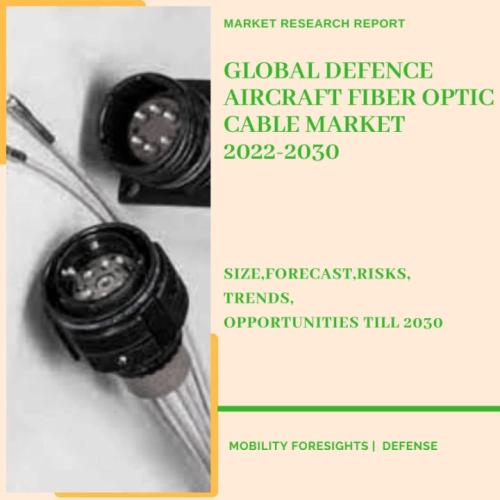
- Get in Touch with Us

Last Updated: Apr 27, 2025 | Study Period: 2022-2030
A network cable with glass fibre strands inside of an insulated housing is known as a fibre optic cable. They are made for telecommunications and long-distance, high-performance data networking.
For high-speed data transfer for uses including mission data, flight planning data, and sensor data fusion for weapon systems in military aircraft, fibre optic cables are utilised in avionics and mission control systems.

The Global defence aircraft fiber optic cable market accounted for $XX Billion in 2021 and is anticipated to reach $XX Billion by 2030, registering a CAGR of XX% from 2022 to 2030.
The new GORE Fiber Optic Cables, 1.8 mm Simplex with high impact-resistance for harsh defence aircraft settings have been released by W. L. Gore & Associates, Inc.
For greater durability and to maintain high-bandwidth data and video transmission on 10-Gb avionics networks, this version has been shown to surpass new, stricter JN1177 and EN4641-301 industry standards.
In order to design and develop the new Centaur High-Speed Cable Assembly, Amphenol Aerospace teamed up with Samtec.
The Centaur High-Speed Cable Assembly combines Samtec's ExaMAX high-speed backplane system with Amphenol's extensive array of mil-spec connectors to provide robust, thoroughly tested high-bandwidth connections that are perfect for application in aerospace and military.
For communication systems to connect to the global information grid of shared data and information, they need a lot of tactical equipment. Data for intelligence, surveillance, and reconnaissance is transmitted through a variety of communication systems via fiber optic cable networks.
Because they enable secure data transmission across secure data links, communication systems, interconnected ground links, and satellites are crucial components of communication networks. As a result, the expansion of the aerospace and military fiber optic market for communication systems is aided by each of these elements taken as a whole.
Prysmian Group, ITT INC., Carlisle Interconnect Technologies, Raytheon Technologies Corporation, and Amphenol Corporation are a few major players in the market for fiber optics in the aerospace and military sectors.In 2021, Amphenol Corporation acquired Positronic to provide customers with a broad range of products and technical design support for their interconnect solutions.
Radiall bought Timbercon in 2020, giving Timbercon the ability to offer even more products to their customers. The aerospace, defense, medical, data storage, telecommunications, industrial, broadcast, and networking markets all benefit from Timbercon's fiber-optic interconnect technology.
Fiber-optic cables are safer for risky activities and are lighter and smaller than metal cables. Additionally, they exhibit superior fatigue endurance. Due to effective flight management systems, communication systems, in-flight entertainment systems, electronic warfare avionics, cabin interiors, and radar systems, the demand for fiber optic in aerospace and military communications is on the rise.
The expansion of fiber optics in the aerospace and military sectors is aided by the rising demand for aircraft with increased airframes, reliability, and bandwidth.
Advanced communication systems are used by the aerospace industry and the military to make it easier for personnel at various locations to communicate with the base station or ground station effectively and continuously. As a result, technologically advanced and high-speed communication systems are in high demand in these two sectors.
Access to real-time data with minimal risk of data loss is the primary benefit of high-speed data transfer solutions. One of the main reasons that manufacturers of aerospace and defense communication systems are interested in fiber optic cables is that they are able to transfer data at a high speed over longer distances. The aerospace and military fiber optic market continues to expand as a result of such developments.
| Market Segmentation |
| Scope of the report |
| Abbreviations |
| Research Methodology |
| Executive Summary |
| Introduction |
| Insights from Industry stakeholders |
| Cost breakdown of Product by sub-components and average profit margin |
| Disruptive innovation in the Industry |
| Technology trends in the Industry |
| Consumer trends in the industry |
| Recent Production Milestones |
| Component Manufacturing in US, EU and China |
| COVID-19 impact on overall market |
| COVID-19 impact on Production of components |
| COVID-19 impact on Point of sale |
| Market Segmentation, Dynamics and Forecast by Geography, 2022-2030 |
| Market Segmentation, Dynamics and Forecast by Product Type, 2022-2030 |
| Market Segmentation, Dynamics and Forecast by Application, 2022-2030 |
| Market Segmentation, Dynamics and Forecast by End use, 2022-2030 |
| Product installation rate by OEM, 2022 |
| Incline/Decline in Average B-2-B selling price in past 5 years |
| Competition from substitute products |
| Gross margin and average profitability of suppliers |
| New product development in past 12 months |
| M&A in past 12 months |
| Growth strategy of leading players |
| Market share of vendors, 2022 |
| Company Profiles |
| Unmet needs and opportunity for new suppliers |
| Conclusion |
| Appendix |